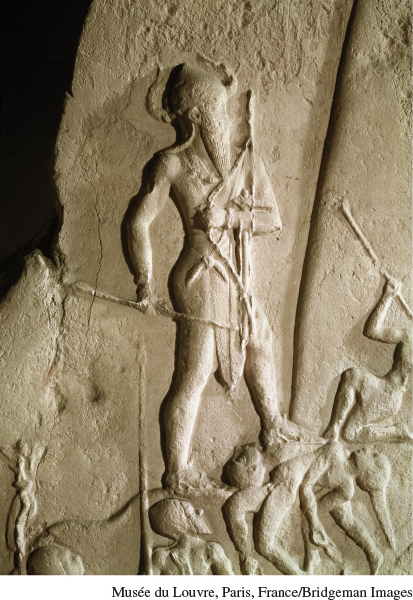Hierarchies of Class
AP® EXAM TIP
You need to know about the development of and characteristics of different classes of people, or “social hierarchies,” in early civilizations.
Alongside the occupational specialization of the First Civilizations lay their vast inequalities — in wealth, status, and power. As ingenuity and technology created more productive economies, the greater wealth now available was everywhere piled up rather than spread out. Early signs of this erosion of equality were evident in the more settled and complex gathering and hunting societies and in agricultural chiefdoms, but the advent of urban-based civilizations multiplied and magnified these inequalities many times over, as the more egalitarian values of earlier cultures were everywhere displaced. This transition represents one of the major turning points in the social history of humankind.
Guided Reading Question
▪CHANGE
In what ways was social inequality expressed in early civilizations?
As the First Civilizations took shape, inequality and hierarchy soon came to be regarded as normal and natural. Upper classes everywhere enjoyed great wealth in land or salaries, were able to avoid physical labor, had the finest of everything, and occupied the top positions in political, military, and religious life. Frequently, they were distinguished by the clothing they wore, the houses they lived in, and the manner of their burial. Early Chinese monarchs bestowed special robes, banners, chariots, weapons, and ornaments on their regional officials, and all of these items were graded according to the officials’ precise location in the hierarchy. In Mesopotamia, the punishments prescribed in the famous Code of Hammurabi (hahm-moo-RAH-bee) depended on social status. A free-born commoner who struck a person of equal rank had to pay a small fine, but if he struck “a man who is his superior, he [would] receive 60 strokes with an oxtail whip in public.” Clearly, class had consequences.

In all of the First Civilizations, free commoners represented the vast majority of the population and included artisans of all kinds, lower-level officials, soldiers and police, servants, and, most numerous of all, farmers. It was their surplus production — appropriated through a variety of taxes, rents, required labor, and tribute payments — that supported the upper classes. At least some of these people were aware of, and resented, these forced extractions and their position in the social hierarchy. Most Chinese peasants, for example, owned little land of their own and worked on plots granted to them by royal or aristocratic landowners. An ancient poem compared the exploiting landlords to rats and expressed the farmers’ vision of a better life:
Large rats! Large rats!
Do not eat our spring grain!
Three years have we had to do with you.
And you have not been willing to think of our toil.
We will leave you,
And go to those happy borders.
Happy borders, happy borders!
Who will there make us always to groan?8
AP® EXAM TIP
You should know that forms of “coerced labor,” like slavery, were common features of many civilizations until the twentieth century. Take good notes on this important type of labor system.
At the bottom of social hierarchies everywhere were slaves. Evidence for slavery dates to well before the emergence of civilization and was clearly present in some gathering and hunting societies and early agricultural communities. But the practice of “people owning people” flourished on a larger scale in the urban- and state-based societies of civilizations. Female slaves, captured in the many wars among rival Mesopotamian cities, were put to work in large-scale semi-industrial weaving enterprises, while males helped to maintain irrigation canals and construct ziggurats. Others worked as domestic servants in the households of their owners. In all of the First Civilizations, slaves — derived from prisoners of war, criminals, and debtors — were available for sale; for work in the fields, mines, homes, and shops of their owners; or on occasion for sacrifice. From the days of the earliest civilizations until the nineteenth century, slavery was everywhere an enduring feature of these more complex societies.
Its practice in ancient times, however, varied considerably from place to place. Egypt and the Indus Valley civilizations initially had far fewer slaves than did Mesopotamia, which was highly militarized. Later, the Greeks of Athens and the Romans employed slaves far more extensively than did the Chinese or Indians (see Chapter 5). Furthermore, most ancient slavery differed from the type of slavery practiced in the Americas during recent centuries: in the early civilizations, slaves were not a primary agricultural labor force; many children of slaves could become free people; and slavery was not associated primarily with “blackness” or with Africa.